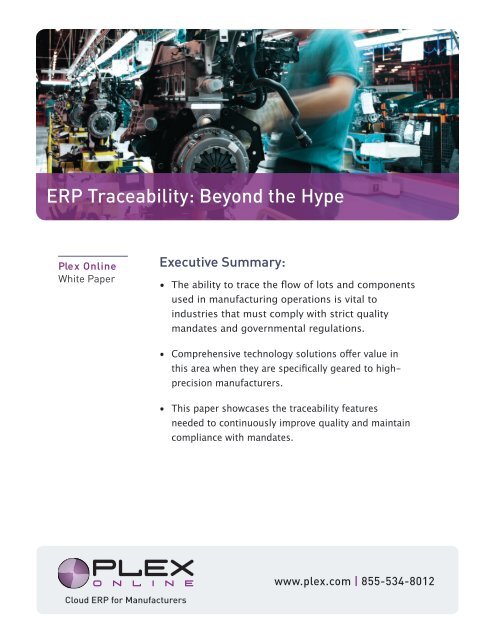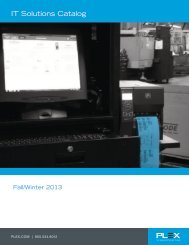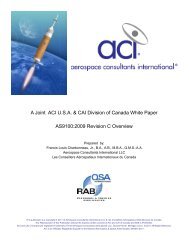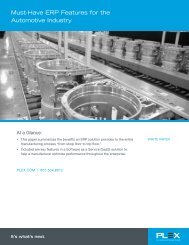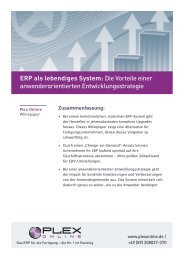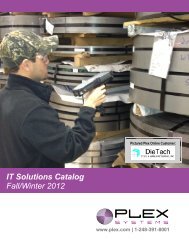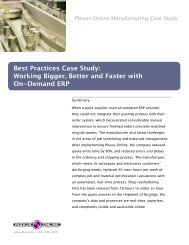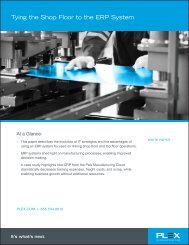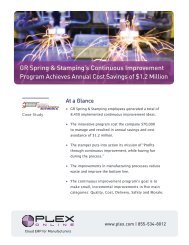ERP Traceability: Beyond the Hype - Plex Systems
ERP Traceability: Beyond the Hype - Plex Systems
ERP Traceability: Beyond the Hype - Plex Systems
Create successful ePaper yourself
Turn your PDF publications into a flip-book with our unique Google optimized e-Paper software.
<strong>ERP</strong> <strong>Traceability</strong>: <strong>Beyond</strong> <strong>the</strong> <strong>Hype</strong><br />
<strong>Plex</strong> Online<br />
White Paper<br />
Executive Summary:<br />
• The ability to trace <strong>the</strong> flow of lots and components<br />
used in manufacturing operations is vital to<br />
industries that must comply with strict quality<br />
mandates and governmental regulations.<br />
• Comprehensive technology solutions offer value in<br />
this area when <strong>the</strong>y are specifically geared to highprecision<br />
manufacturers.<br />
• This paper showcases <strong>the</strong> traceability features<br />
needed to continuously improve quality and maintain<br />
compliance with mandates.<br />
Cloud <strong>ERP</strong> for Manufacturers<br />
www.plex.com | 855-534-8012
<strong>Plex</strong> Online White Paper | page 2<br />
A Hard Truth<br />
It is alarming to note that U.S. manufacturers spend over $25 billion every<br />
year on product warranty claims. (Source: IDC).<br />
“<strong>Traceability</strong>: tracing goods<br />
and processes backward<br />
along <strong>the</strong> supply chain and<br />
forward along <strong>the</strong> distribution<br />
chain based on identifying<br />
characteristics.”<br />
These same industry analysts<br />
also report that warranty costs<br />
in <strong>the</strong> automotive industry<br />
exceed $9 billion per year.<br />
Direct warranty costs are<br />
not <strong>the</strong> only consideration.<br />
Indirect costs must take<br />
into account <strong>the</strong> significant<br />
loss of sales due to negative<br />
publicity.<br />
The Role of Regulation<br />
Increasingly complex government and industry regulations play a big part in<br />
<strong>the</strong> rising costs of warranty. Government regulations include:<br />
The TREAD Act: The Transportation Recall Enhancement, Accountability<br />
and Documentation (TREAD) Act requires that vehicle manufacturers<br />
report to <strong>the</strong> National Highway Traffic Safety Administration (NHTSA) when<br />
<strong>the</strong>y conduct a safety recall or o<strong>the</strong>r safety campaign in a foreign country.<br />
The TREAD regulation mandates that vehicle manufacturers report<br />
information related to defects, reports of injury or death related to <strong>the</strong>ir<br />
products, as well as o<strong>the</strong>r relevant data in order to comply with “Early<br />
Warning” requirements. The “Early Warning” requirement is <strong>the</strong> heart of<br />
<strong>the</strong> TREAD Act, enabling <strong>the</strong> NHTSA to collect data, notice trends, and<br />
warn consumers of potential defects in vehicles.<br />
The TREAD Act assigns criminal liability when a vehicle manufacturer<br />
intentionally violates <strong>the</strong> new reporting requirements when a safety-related<br />
defect has subsequently caused death or serious bodily injury. There are a<br />
number of o<strong>the</strong>r smaller provisions which mostly address manufacturers of<br />
vehicle tires and guidance to <strong>the</strong> NHTSA on reporting data.<br />
www.plex.com | 855-534-8012
<strong>Plex</strong> Online White Paper | page 3<br />
Aerospace Regulation: Important regulations include <strong>the</strong> AS9100:<br />
International Aerospace Quality Group, including <strong>the</strong> SAE (US), European<br />
Association of Aerospace Industries, and Asian industry groups. Initially<br />
released in October 1999, and revised in 2001, <strong>the</strong> mandates provide <strong>the</strong><br />
essentials of an effective traceability program.<br />
Medical Equipment Regulation: In <strong>the</strong> medical equipment manufacturing<br />
arena, FDA Medical Device Reporting (MDR) regulations have required<br />
firms that have received complaints of device malfunctions, serious<br />
injuries or deaths associated with medical devices to notify FDA of <strong>the</strong><br />
incident.<br />
The Safe Medical Devices Act (SMDA) provided FDA with two additional<br />
post-marketing activities, Postmarket Surveillance for <strong>the</strong> monitoring<br />
of products after <strong>the</strong>ir clearance to market and Device Tracking for<br />
maintaining traceability of certain devices to <strong>the</strong> user level.<br />
The bottom line is that consumers, customers, government agencies, and<br />
courts expect increasingly higher quality standards and levels of corporate<br />
responsibility. It’s up to <strong>the</strong> manufacturer and supply chain to track <strong>the</strong>ir<br />
processes and business information so critical safety-related decisions and<br />
operations related to warranty issues can be properly analyzed.<br />
For automotive, aerospace, and medical equipment manufacturers and<br />
suppliers, adhering to warranty-related reporting requirements can make all<br />
<strong>the</strong> difference.<br />
The Role of Technology<br />
Today’s information technology solutions create electronic databases of<br />
decisions (e.g., safety vs. cost tradeoffs in design) that can be tapped by<br />
lawyers looking for evidence, or by <strong>the</strong> manufacturing companies <strong>the</strong>mselves<br />
when faced with warranty issues.<br />
This means that information technology systems have become powerful tools<br />
for manufacturers to isolate quality, warranty, or safety issues and minimize<br />
disruption to production.<br />
This is <strong>the</strong> concept of “traceability,” which is defined as <strong>the</strong> capability for<br />
tracing goods backward along <strong>the</strong> supply chain and forward along <strong>the</strong><br />
distribution chain based on identifying characteristics.<br />
www.plex.com | 855-534-8012
<strong>Plex</strong> Online White Paper | page 4<br />
Short- and Long-Term Benefits of <strong>Traceability</strong><br />
The short-term goals of <strong>the</strong> traceability function are to identify products<br />
impacted by <strong>the</strong> defect after customer delivery to minimize recall costs. This<br />
works to minimize <strong>the</strong> number of products that must be recalled when a<br />
manufacturing flaw is found by identifying only <strong>the</strong> specific serial numbers<br />
that were built with <strong>the</strong> faulty component/material or by <strong>the</strong> faulty process.<br />
More important, <strong>the</strong> proactive, long-term result of traceability is to identify<br />
defects prior to customer delivery to reduce in-process costs (<strong>the</strong> reactive,<br />
short-term benefit) and eliminate <strong>the</strong> need and costs of a recall (proactive,<br />
long-term benefit).<br />
Eliminating Recalls<br />
In essence, parts traceability information technology solutions eliminate<br />
recalls in <strong>the</strong> first place by providing real-time reports on <strong>the</strong> machines,<br />
components, stations, shifts, and operators involved in <strong>the</strong> defective product<br />
and processes before <strong>the</strong> product is shipped.<br />
Manufacturers are wise to implement a complete solution that provides realtime<br />
traceability features to accurately track individual containers and/or<br />
pieces as <strong>the</strong>y flow through <strong>the</strong> entire manufacturing value chain. These<br />
solutions must be able to not just provide historical information— <strong>the</strong>y must<br />
isolate problems with exact data related to production, inspection, genealogy,<br />
and usage.<br />
<strong>Traceability</strong> Best Practices<br />
“For this bearing supplier,<br />
parts traceability results in<br />
defect-free components.”<br />
As a way to showcase a<br />
best practice approach in<br />
traceability, <strong>the</strong> experience<br />
of a regional tier two bearing<br />
supplier serves as a fitting<br />
example.<br />
A large US-based tier one<br />
manufacturer began searching for a new component supplier for a unitized<br />
center bearing (UCB) component used in its customers’ cars and trucks.<br />
www.plex.com | 855-534-8012
<strong>Plex</strong> Online White Paper | page 5<br />
The previous UCB supplier had serious quality problems, which exposed<br />
shortcomings in its inventory control and increased <strong>the</strong> potential of future<br />
warranty costs.<br />
The issue’s root cause was a rubber bushing which sometimes became too<br />
hard and worked to reduce <strong>the</strong> UCB’s dampening ability and allowed normal<br />
driveshaft vibrations to be transmitted into <strong>the</strong> passenger compartment.<br />
The previous bearing supplier only had <strong>the</strong> ability to label each part with just<br />
a Julian date, and so it was assumed that all parts marked with that date<br />
were suspect.<br />
The limitation in this situation was that <strong>the</strong>re was no traceability to ensure <strong>the</strong><br />
tier one’s parts produced <strong>the</strong> days before and after shouldn’t be contained as<br />
well. In fact, <strong>the</strong> tier one manufacturer rejected a total of three days’ worth of<br />
parts every time a defect was found.<br />
<strong>Traceability</strong> as a Competitive Advantage<br />
A strategic technology solution let <strong>the</strong> bearing supplier easily manage part<br />
serialization, barcoding, component tracking, quality management, SPC/<br />
measurement data, and full part traceability.<br />
<strong>Plex</strong> Online provided <strong>the</strong> bearing supplier not only <strong>the</strong> production date/<br />
time, but also <strong>the</strong> machines and operators that made it, <strong>the</strong> in-process<br />
measurement data, <strong>the</strong> supplier and serial numbers of <strong>the</strong> components that<br />
went into it, <strong>the</strong> steel chemistry of <strong>the</strong> raw material, and much more.<br />
For this bearing supplier, <strong>the</strong> combined capabilities of process control and<br />
traceability have allowed <strong>the</strong> company not only to produce <strong>the</strong> UCB without<br />
major problems, but also to make multiple design changes that have radically<br />
improved <strong>the</strong> part’s performance.<br />
The company gained <strong>the</strong>se benefits from a technology that offered much<br />
more than just a quality documentation system. <strong>Plex</strong> Online was designed<br />
specifically for manufacturers to increase process repeatability, reduce<br />
variation, increase production throughput, and reduce defects.<br />
The online system provided <strong>the</strong> bearing tier two supplier with an automatic,<br />
paperless, and real-time linkage between part dimensions, FMEA, control<br />
plan, process instructions, check sheets, inspection data collection, and SPC,<br />
along with part layouts, PPAPs, gage studies, and capability studies.<br />
www.plex.com | 855-534-8012
<strong>Plex</strong> Online White Paper | page 6<br />
<strong>Plex</strong> Online as a Competitive Advantage<br />
As revealed in <strong>the</strong> best practices<br />
case study included here, <strong>Plex</strong><br />
Online helps <strong>the</strong> manufacturing<br />
enterprise dramatically reduce<br />
<strong>the</strong> cost and effort of improved<br />
part quality.<br />
Comprehensive traceability<br />
features accurately track<br />
individual containers and/or<br />
pieces as <strong>the</strong>y flow through <strong>the</strong><br />
manufacturing process and <strong>the</strong><br />
entire supply chain, and can<br />
quickly isolate problems with<br />
pinpoint precision. Detailed<br />
historical information tracks production, inspection, genealogy, and usage.<br />
Capabilities include serialized container and individual part tracking, built-in<br />
barcode printing and scanning, RFID, and Direct Part Marking, and detailed<br />
container-to-container traceability both upstream and downstream from any<br />
point in <strong>the</strong> process and/or shipped parts.<br />
About <strong>Plex</strong> Online<br />
<strong>Plex</strong> Online, built on a Software as a Service (SaaS) Cloud model, offers more than 400 functions, providing<br />
manufacturers instant access to vital information and management features using a simple Web browser. The ondemand<br />
solution includes product lifecycle management (PLM) functions such as program and change management;<br />
enterprise resource planning (<strong>ERP</strong>) functions such as accounting and finance programs; customer relationship<br />
management (CRM) functions such as order entry and tracking; manufacturing execution systems (MES) functions such<br />
as production scheduling and machine integration; and supply chain management (SCM) functions such as supplier<br />
quality and traceability. For more information, see www.plex.com.<br />
Cloud <strong>ERP</strong> for Manufacturers<br />
www.plex.com | 855-534-8012


